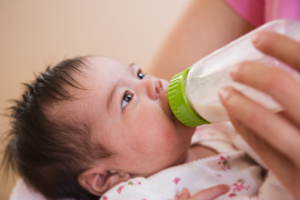Overview

What are infant formulas?
Infant formula is a nutritional product. It's made from processed cow's milk or soybean products. Special processing makes cow's-milk formula more digestible and less likely to cause an allergic reaction than regular cow's milk.
Vitamins and minerals are added to infant formula. Formula can be used to provide all of a baby's nutritional needs before the age of 4 to 6 months.
Commercial formulas are made to be as similar to breast milk as possible. The safety and nutrient content of infant formula is regulated by the U.S. Food and Drug Administration (FDA).
About half the calories in formula come from vegetable oils or a mixture of vegetable and animal fats. A baby's body requires fat to make and grow new cells and to support a baby's high energy needs.
Milk sugar (lactose) is the main source of carbohydrate in most cow's-milk formula, just as in breast milk.
What are some types of formulas?
Several types of infant formulas are available. Usually cow's-milk formulas are tried first.
Vitamins and minerals, including iron, are added to infant formula. Formula-fed babies can become low in iron (iron-deficient) if iron-fortified formulas aren't used.
There are other types of formulas for babies who have trouble digesting cow's-milk formulas. Talk to your doctor before you give your baby one of these formulas.
- Soy formulas may be recommended for babies who can't tolerate cow's-milk formulas or for parents who choose a vegetarian diet for their baby. People also may choose soy formulas for cultural, ethical, or religious reasons. Soy formula isn't recommended for all infants. It should not be given to any infant who has a soy protein allergy.
- Lactose-free formulas are used for babies who are lactose-intolerant. This is a rare problem in babies.
- Hydrolyzed protein or amino acid formulas are used for babies who can't tolerate formulas made from cow's milk or soy.
Do not use homemade formulas, such as those that use evaporated milk. These do not have the nutrients and supplements your baby needs. They could also make your baby sick.
Follow-up formulas for toddlers are also available. They usually contain more iron and other nutrients than other formulas. Most healthy children don't need these formulas.
How do you prepare formula?
You can buy formula as a powder or as a concentrated or ready-to-feed liquid. Ready-to-feed formulas cost the most. But some caregivers find their convenience worth the extra cost. You must add cool, safe water to powders and concentrates. Be sure to follow the directions on the label and use the measuring device that comes with the product.
- Use the formula within 1 hour of starting a feeding, or within 2 hours of preparing it.
- If you aren't going to use the formula right away, you can put it in the refrigerator for up to 24 hours.
- Throw out any formula that's left in the bottle after feeding your baby.
- Cover and store your open cans or bottles of ready-to-feed and concentrated liquid product in the refrigerator for no more than 48 hours.
- Cover and store both opened and unopened cans of powder formula in a cool, dry place—not in the refrigerator. You can use the powder product for up to 4 weeks, if it's stored right. Don't leave prepared formula out of the refrigerator.
If you have any trouble feeding your baby, talk to your doctor or nurse.